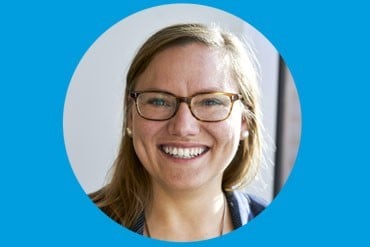
Interview : Stephanie Forkel
After Michel Thiébault de Schotten, who arrived at the GIN in 2019 and became the team leader last January, several new members joined the team at the end of last year: Hervé Lemaître, Patrick Friedrich et Stéphanie Forkel… Let’s meet ont of them today.

Bordeaux Neurocampus: Hello Stephanie. What is your research topic at Bordeaux Neurocampus?
Stephanie Forkel: My research focuses on using neuroimaging methods to map inter-individual variability in the structure and function of the brain and how this variability impacts on cognition and functional recovery after brain damage (e.g. stroke and tumour).
You have some publications with Patrick Friedrich, who arrived at the same time as you, and Michel Thiebaut de Schotten, the team leader of the GIN. What can you tell us about your collaborations? Is it in this context that you came to Bordeaux Neurocampus?
The GIN was the first neuroimaging group in France and was instrumental in shaping the field of human brain mapping.
I was aware of GIN’s international reputation and their outstanding work on interindividual variability and functional lateralisation. Michel and I have started working together in London some ten years ago and have since had several joint research and science outreach projects. Patrick joined the fray at the end of last year. Despite this rather short period, we have developed a very productive working style based on our complementary skills and backgrounds. Arriving in Bordeaux at the time when Michel had taken over the lead of the group was very exciting. Having previously worked together meant we could hit the ground running and I was able to immerse myself in the local expertise of the GIN and learn about exciting new research while contributing my skillset to the team. I am delighted to have found a place to advance my scientific training, gain new skills, and be working with a wonderful and supportive group of people.
Can you tell us about your involvement in science dissemination, which you practice in addition to research?
I am an associate editor for the journal Cortex and a reviewer for over 20 other journals and several funding agencies. I much enjoy this activity as I am one of the first ones to see novel discoveries, and I can have a positive impact on our field. Early on in my career, I had the great honour of contributing to the Lindau Nobel Laureate Meeting for Medicine or Physiology and the German Scholar Organisation Leadership Academy. Both meetings have had a lasting impact on me, and I am still an active alumna with both. Recently, I received the Academics top10 Young scientist award, which is acknowledging dedicated and talented young researchers for outstanding contributions to science and science communication.
You have engaged in many science outreach and policy activities. Can you tell us about a few?
I am very passionate about science outreach in any form and shape. Over the years, I have experimented with different types of outreach. For example, I worked with television (BBC), curated art exhibits (Science Gallery London, Wellcome Trust Image award), gave public science talks (Pint of science), taught in bilingual schools (Native scientists), and interviewed the Nobel Laureate Professor Elizabeth Blackburn in honour of International Women’s Day. I have also contributed to science policy advisory activities (e.g. British Research Council, Sueddetusche Zeitung). Having studied politics in a previous life, I am still very intrigued by how science and politics influence each other. With a multinational background and after having lived in several countries, I gained insights into the different academic systems and how they interact with politics.
I am very excited to bring some of these activities with me to Bordeaux. Amongst them are the use of 3D printing for outreach projects and the Clinical Neuroanatomy Seminars (www.clinicalneuroanatomyseminars.com). The CNSeminars are scientific talks that we stream live online and then collect in a repository.
You have a Twitter account, and you publish regularly. Is social media a must-have for scientists, in neuroscience or other fields?
I was a reasonably late arrival to the Twitterverse, and it did take me a while to get into it. I was a silent observer of the twitter world for a long time. I am much enjoying it now as it offers direct access to so much information and so many people. While there can be a lot of noise as well, I think it is a great platform to share news and engage in a less formal setting. It is also an impactful way to reach outside the scientific silo and engage a broader audience, especially for science outreach projects (e.g. @CNSeminars) and new twitter conferences (e.g. @OHBMequinoX, @worldwideneuro). I wouldn’t say it is a must-have, as it can also greatly help to procrastinate, but I have discovered great discussions, novel research and fantastic initiatives on there.
More details
Reviewer & Editor profile: https://publons.com/researcher/1226824/stephanie-j-forkel/
ResearchGate: https://www.researchgate.net/profile/Stephanie_Forkel2
Twitter: https://twitter.com/StephForkel
LinkedIn: https://www.linkedin.com/in/stephanieforkel/
Last update 03/06/20
